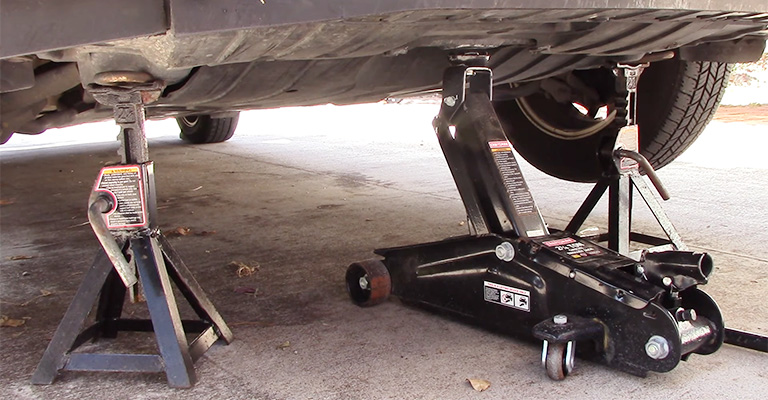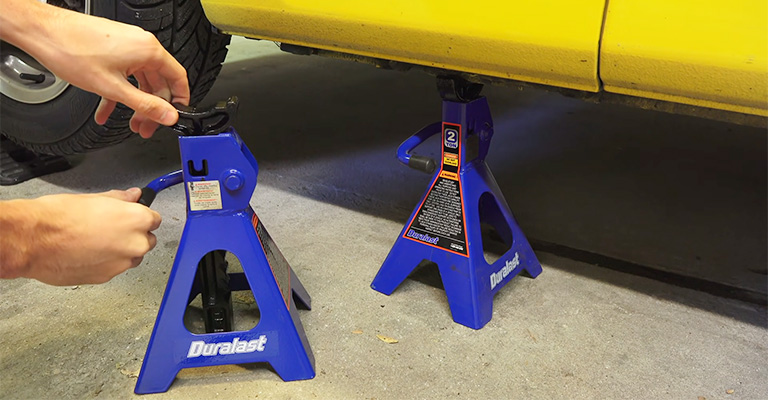The first step of changing a tire on your Honda accord is to jack up your vehicle so you can get under it and remove the flat tire from under your vehicle’s frame.
You will need a floor jack and some blocks or ramps to use as a lift point for your car. Make sure you are on level ground when doing this, or you risk damaging your tires while trying to change them out!
Each front and rear tire has its own tab behind the rocker panels, four in total. Steel bars of 3/8″ x 4″ can be seen underneath the car on the sides. Additionally, a rear tow hook and a front cross member can be used to jack it up.

How to Jack Up Your Accord?
To become a home mechanic, any car owner will need to know how to properly jack up their vehicle. You can learn how to do it easily, but if you do it correctly, you will prevent damage to the car and injure yourself.
An aftermarket jack will make the job much easier and faster than a factory scissor jack. In addition, the car should be blocked from rolling while being jacked, the correct jack point should be used, and jack stands should be acquired to properly secure the car.
1. Pull Over In A Safe Place

Make sure you get off the road and away from the traffic as soon as possible. You should take the exit on the highway if you’re near one. To use a car jack safely, you must get off the road and onto solid ground, such as a parking lot.
Finding your way to a street with relatively little traffic would be best, where you could pull off to the side. Make sure you’re away from traffic and in a solid enough spot to support a jack.
It’s better to find the safest location if you’re on a highway and can’t get off. It is impossible to drive on a flat tire for miles without damaging it and possibly damaging your vehicle.
If you encounter such a situation, pull over to the right shoulder, far enough off the road to avoid accidents. To prevent the jack from sinking into the ground, make sure you’re on a solid, level surface instead of lifting the car.
While the jack is lifting the car, a soft surface may cause it to lean to one side, causing the car to fall.
2. Lift The Car Up

Make sure the car is parked on a level surface. Then, place a pair of wheel chocks behind the rear wheels to prevent the car from rolling backward. Your jack should be placed underneath the front jack point. This is by far the best and strongest jack point, even though there are other suitable places.
Four other jack points are shown on the factory jack, including two behind the front tires and two behind the rear tires. So, you can now jack the car up to the height you desire.
Make sure you chock the wheels at the other end of the car if you are only jacking up one end. Choking, on the other hand, means blocking the car with something heavy and large to prevent it from moving. Ramps, wooden planks, and cinder blocks can also be used.
3. Make Sure Jack Stands Support The Car

The points behind the front and rear wheels of the car can be used to support the car with jack stands. A jack stand’s height can be adjusted by pulling up the lever, and the length can be adjusted by moving the rod up or down.
You should slowly and carefully lower the jack once the stands are in place until the car is securely resting on the stands. The jack stands should be balanced and centered. Take your time and adjust them as needed.
You should use a durable floor jack with a long handle if you are jacking up the car at home to work on it. The onboard jack on a car’s dashboard is less stable than the jack used at car repair shops and racetracks.
Final Words
You can remove the jack when the car’s tire is firmly in contact with the ground, and you’re ready to lower it. When you return the jack to its storage spot, you’re almost ready to go. Do not forget to remove any blockage you used, or you might think the parking brake is stuck when you start the engine.

Leave a Reply